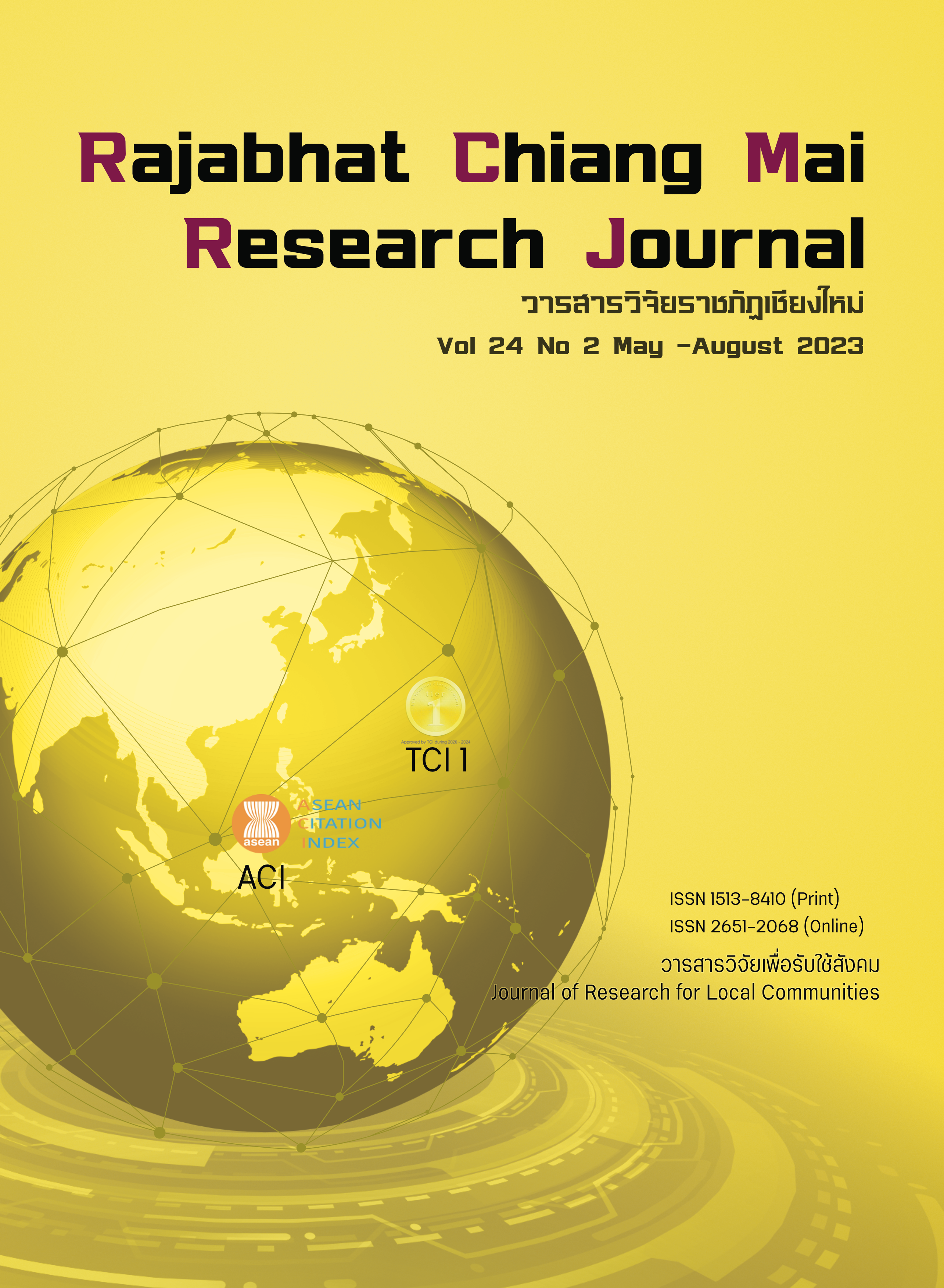A Survey on Teachers’ Attitudes Towards Bilingual Education (Thai-Tai Yai based) for Border Schools in Mae Hong Son, Thailand
DOI:
https://doi.org/10.57260/rcmrj.2023.262737Keywords:
Attitudes, Survey, Bilingual, Education, Border schoolAbstract
This paper aimed to carry out a preliminary survey on teachers’ attitudes towards bilingual education (Thai-Tai Yai based) for local schools in border areas of Pang Mu areas, Mueang district of Mae Hong Son Province of Thailand, to reveal 1) the feasibility and requirements of implementing MTB program(s) in border schools; 2) the nature and implementation of MTB materials; and 3) the nature and implementation of MTB curricula. The research population was 109 teachers from 18 educational institutions. The research instruments were 1) a survey form about language and language use in schools and 2) a questionnaire consisting of five sections: basic information of the respondents; opinions on the management of bilingual education; cost and need for creating primary bilingual media, bilingual courses; and suggestions, respectively. Data were analyzed quantitatively and qualitatively by using frequency, percentage, summation, and arithmetic mean. The results were that (1) the teachers were not ready for any form and aspect of teaching instructions—having few costs and making few demands for building and creating media for bilingual instructions in five related issues as follows: solid foundational media; primary media for listening-speaking Thai; preparation for reading-writing the Thai language; development of reading-writing skills in Tai Yai language with Thai characters; and enhancement of reading-writing skills with reading materials in Tai Yai language; (2) the teachers have few costs and needs for creating a bilingual model course in their schools on eight bases, namely: educational standards; Thai/Tai Yai languages; Thai/Tai Yai cultures; local needs conformity; basic language skills; multicultural understanding, Tai Yai cultural conservation; and teaching plans in bi/multilingual education, and; (3) the teachers lack knowledge, understanding of bi/multilingualism principles, and experiences. Conclusively, bilingual (Thai-Tai Yai) education was not a ready requirement for schools in Mae Hong Son border areas.
Downloads
References
Baker, C. (2001). Foundations of Bilingual Education and Bilingualism (3rd ed .). Clevendon Multilingual Matters LTD.
Benson, J.C. (2002a). Real and Potential Benefits of Bilingual Programes in Developing Countries. Retrived from https://doi.org/10.1080/13670050208667764
Cambridge Assessment International Education. (2017). Bilingual learners and bilingual education. Retrieved from https://rb.gy/jbse79
Cambridge Assessment International Education. (2017). Bilingual learners and bilingual education. Retrieved from www.cambridgeinternational.org/events
Chiang Mai News. (2020). “Mae Hong Son” has championed the northern poor title since 2006. Retrieved from https://rb.gy/xk4e6t (In Thai)
Cummins, J. (2001). Bilingual Children’s Mother Tongue: Why Is It Important for Education? Sprogforum, 7(19), 15-20.
Kannaowakun, P. et.al. (2010). A development model for bilingual communication abilities at the elementary level of the three southern border provinces’ students. Songklanakarin Journal of Social Sciences and Humanities, 16(6), 933-952. https://so05.tci-thaijo.org/index.php/psujssh/issue/view/6195 (In Thai)
Kosonen, K. (2005). Education in local languages: Policy and practice in South-East Asia. Asia-Pacific Program of Education for All First Language First: Community-based Literacy Programme for Minority Language Contexts in Asia. Bangkok: UNESCO Bangkok.
Luangthongkum, T. (2014). Proto-Karen (*k-rjanA) Fauna. MANUSYA Journal of Humanities, 17(1), 86-123. http://www.manusya.journals.chula.ac.th/issue-read.php?essay=364
Maryanto (2008, 19-21 February). Language Policy in Indonesian Education: Regional and Local Languages as Oral Languages of Instruction [Paper presentation]. The Regional Consultative Workshop on “Using the Mother Tongue as Bridge Language of Instruction in Southeast Asian Countries: Policy, Strategies and Advocacy”. Bangkok, Thailand. https://documents1.worldbank.org/curated/en/527021468104056444/pdf/563290PUB0Box31guage0of0Instruction.pdf
Ministry of Education. (2007). A research report on the development of Thai language teaching policy in southern border provinces. Office of the Education Council. Bangkok, Thailand. (In Thai)
Ministry of Education. (2008). Core Curriculum for Basic Education. Retrieved from http://math.ipst.ac.th/wp-content/uploads/2015/PDF/Curriculum%202551.pdf. (In Thai)
Ministry of Education. (2020). National O-NET Evaluation Results for Primary Level 6 (Mae Hong Son). Retrieved from https://sp.moe.go.th/sp_2563/info/?module=page_onet_ province&id_province=58 (In Thai)
Malone, S. (2010). Planning Mother Tongue-Based Education Programs in Minority Language Communities. Dallas: SIL International. Retrieved from https://www.sil.org/system/files/reapdata/37/28/09/37280955906615243006691430940780490013/MLE_Program_Planning_Manual.pdf
Office of Mae Hong Son Culture. (2021). Ethnic Minority Groups of Maehongson Province. Darawan Printing Ltd. Thailand: Maehongson. (In Thai)
Office of the National Economic and Social Development Council. (2019). O-NET Average Results by Subjects and Levels of 2003-2018. Retrieved from http://social.nesdc.go.th/SocialStat/StatReport_Final.aspx?reportid=3675&template= 2R2C&yeartype=M&subcatid=21 (In Thai)
Pang Mu Administrative Organization. (2020). Tambon Pang Mu Subdistrict Profile in 2020. Thailand: Maehongson. (In Thai)
Siegel, H. (1997). Philosophy of Education. Teaching Philosophy, 20(1), 83-88. DOI: 10.5840/teachphil199720111
The National Institute of Educational Testing Service. (2020). O-NET Test Results for Primary Level 6. Retrieved from http://www.newonetresult.niets.or.th/AnnouncementWeb/ PDF/SummaryONETP6_2563.pdf (In Thai)
Thomas, W.P. & Collier, V.P. (2003). Educational Leadership: The multiple benefits of dual language. Teaching All Students, 61(2), 61-64. Retrieved from https://files.ascd.org/staticfiles/ascd/pdf/journals/ed_lead/el200310_thomas.pdf
UNESCO. (2005a). Education for All: The Quality Imperative. Retrieved from https://en.unesco.org/gem-report/report/2005/education-all-quality-imperative
UNESCO. (2005b). UNESO Forum on higher education, research and knowledge, no. 1. Retrieved from https://unesdoc.unesco.org/ark:/48223/pf0000150429
UNICEF’s Next Generation Viet Nam. (2013). UNICEF Bilingual education in Viet Nam. Retrieved from https://www.youtube.com/watch?v=gKK5I4mO8ZE
World Bank. (2004). World Development Indicators 2004. Washington, D.C.
Downloads
Published
How to Cite
Issue
Section
License
Copyright (c) 2023 Rajabhat Chiang Mai Research Journal

This work is licensed under a Creative Commons Attribution-NonCommercial-NoDerivatives 4.0 International License.
1. Articles, information, content, images, etc published in the “Community and Social Development Journal” are copyrighted by the Community and Social Development Journal, Chiang Mai Rajabhat University. In order to properly distribute the articles through print and electronic media, the authors still hold the copyright for the published articles under the Creative Commons Attribution (CC BY) license, which allows the re-distribution of the articles in other sources. References must be made to the articles in the journal. The authors are responsible for requesting permission to reproduce copyrighted content from other sources.
2. The content of the articles appearing in the journal is the direct responsibility of the article authors. The editorial board of the journal does not necessarily agree with or share any responsibility.














